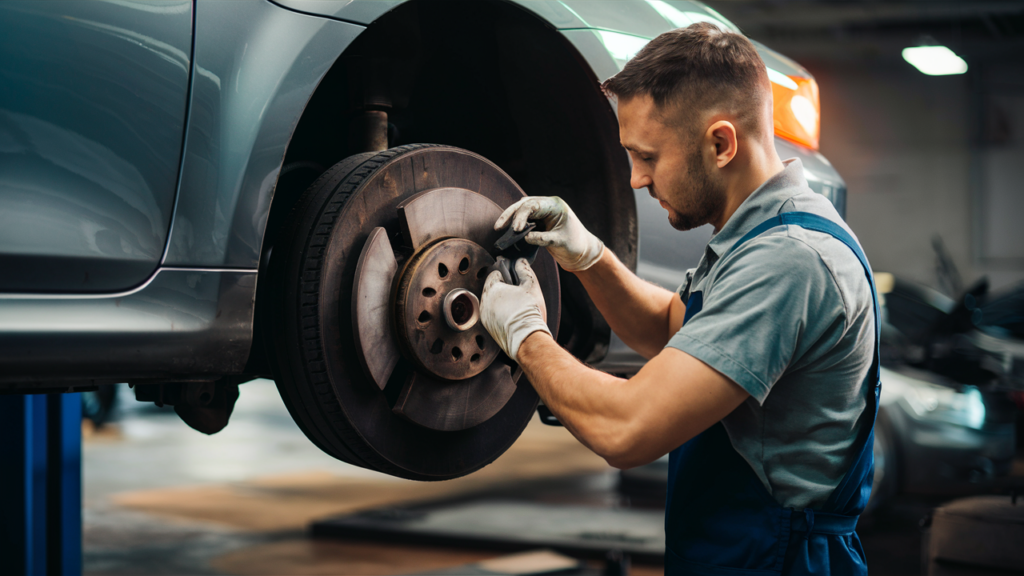
Everything You Need to Know About Car Brake Pads
Meaning:
Car brake pads are a crucial component of the braking system in vehicles. They are designed to convert kinetic energy into thermal energy through friction, allowing the vehicle to slow down or stop. Brake pads are typically made of steel backing plates with friction material bonded to the surface that faces the disc brake rotors. They are mounted on brake callipers and are activated by hydraulic pressure when the driver presses the brake pedal.
Unseen heroes of every vehicular journey, car engine brake pads play a crucial role in ensuring driver safety and vehicle performance. By providing the necessary friction to slow down or halt the vehicle, brake pads are indispensable components in any automobile.
Understanding the nuances of car engine brake pads is essential for drivers seeking to demystify their vehicle’s braking system and elevate their driving experience.Brake pads come in various materials, each with distinct characteristics that influence braking efficiency and longevity.
From organic brake pads offering a smooth operation suitable for everyday driving conditions to semi-metallic ones known for their robustness across diverse vehicles, and high-performing ceramic brake pads that excel in durability and noise reduction – material selection impacts a car’s braking dynamics significantly.
As drivers navigate different terrains and weather conditions, having an understanding of these material variations equips them to make informed decisions when choosing the most suitable brake pads for their driving needs.
Types of Car Engine Brake Pads.
Car engine brake pads come in various types, each offering distinct features to cater to different driving scenarios. Organic brake pads, composed of non-metallic materials like rubber, glass, and Kevlar, excel in providing smooth and quiet braking performance.
Ideal for everyday driving situations where noise reduction and low dust emission are priorities, organic brake pads offer a gentle feel on the pedal while contributing to rotor longevity. These pads are often favored by urban drivers seeking a balance between stopping power and comfort during daily commutes.
Semi-metallic brake pads merge steel or copper filaments with friction materials, making them robust contenders for vehicles that undergo frequent braking or towing activities. Known for their excellent heat dissipation properties, semi-metallic brake pads offer consistent performance under high-stress conditions.

This type suits trucks and SUVs that demand reliable stopping power while maintaining durability over extended usage periods. Drivers who value consistent braking responsiveness across various terrains may find semi-metallic brake pads beneficial for their specific driving needs.
Ceramic brake pads stand out for their superior durability and ability to minimize noise levels during operation. Comprised of ceramic fibers fused with filler material and bonding agents, these pads provide exceptional resistance to heat fade, promoting longer pad life compared to other variants.
Drivers looking for low-maintenance solutions with reduced wear on rotors often opt for ceramic brake pads due to their ability to withstand harsh weather conditions effectively.
Moreover, the absence of metal content significantly reduces noise production during braking actions, enhancing driving comfort particularly on long journeys or in urban environments where traffic congestion is common.
Factors to Consider When Choosing Brake Pads.
When contemplating which brake pads to outfit your vehicle with, two critical factors stand out: thickness and material quality. The thickness of a brake pad directly impacts its longevity and braking performance. Thicker brake pads typically last longer and can endure more heat generated during braking without sacrificing efficiency.
Hence, when selecting brake pads, opting for thicker variants may offer extended service life and consistent braking power. As for material quality, it significantly affects how the brake pads interact with the rotor. High-quality materials like ceramic or carbon fiber can enhance stopping capabilities and reduce wear on both the pads and rotors in comparison to lower-quality alternatives.
Beyond just thickness and material, it’s imperative to account for your driving habits and the environmental conditions you frequently encounter when choosing brake pads. For instance, if you often drive in stop-and-go traffic or hilly terrains that subject your brakes to frequent use, selecting durable brake pads like semi-metallics might be more suitable.

On the contrary, if you prioritize smooth and quiet braking experiences, ceramic brake pads could be a better fit due to their noise reduction properties. Understanding how your car is primarily used will aid in pinpointing the right type of brake pad that aligns with your driving needs while optimizing safety and performance.
Proper installation of brake pads is non-negotiable when aiming for optimal functionality. Even the highest quality brake pads will underperform if not installed correctly. Ensuring proper alignment, caliper clearance adjustment, and torquing down bolts to manufacturer specifications are crucial steps in guaranteeing effective braking performance post-installation.
Whether you’re a seasoned DIY mechanic or seeking professional assistance, meticulous attention to detail during installation is paramount in preserving the integrity of the braking system and enhancing overall safety on the road.
Remember, precision during installation translates into reliability during operation – a cornerstone principle when it comes to selecting and installing brake pads for your vehicle.
Signs of Worn Out Brake Pads.
Recognizing the signs of worn-out brake pads is crucial for maintaining safe driving conditions. A common indicator of deteriorating brake pads is the occurrence of high-pitched squealing noises when applying brakes.
This noise results from a wear indicator built into the brake pad specifically to alert drivers that the pads have reached a critical level of thinness, necessitating replacement.
Ignoring such warning sounds can lead to adverse consequences, including decreased braking responsiveness and longer stopping distances, posing serious safety risks for both the driver and other road users.
Continuing to use depleted brake pads not only compromises driving safety but also escalates the potential for more extensive damage to the braking system. Neglecting these warning signs may result in rotor damage, leading to costlier repairs.

To prevent such scenarios, drivers should proactively inspect their brake pads regularly. An effective visual inspection involves checking through a wheel spokes or openings in the wheel rims to assess the thickness of the remaining pad material.
Any visible signs of excessive wear, such as pads thinner than 1/4 inch, indicate an urgent need for replacement to ensure optimal braking performance and vehicle safety.
Understanding these telltale signs and taking prompt action can prevent hazardous situations on the road caused by worn-out brake pads. By staying vigilant and responsive to these warnings, drivers not only protect themselves and their passengers but also contribute to overall road safety.
Regular visual inspections remain a simple yet essential practice that every driver should incorporate into their routine maintenance habits to ensure that their vehicle’s braking system continues to function reliably and effectively.
Maintenance Tips for Extending Brake Pad Lifespan.
Maintaining your car engine brake pads is essential for optimal performance and safety. To prolong the lifespan of your brake pads, consider the following tips. Firstly, it is highly recommended to schedule regular inspections by trained professionals.
A mechanic can accurately assess the wear levels of your brake pads and determine if they need replacement or servicing to prevent any safety hazards on the road.
Additionally, adopting smooth driving techniques can significantly reduce unnecessary wear on your brake pads. Avoid abrupt stops and starts whenever possible, as these actions put undue stress on the braking system. By driving sensibly and maintaining a safe distance from other vehicles, you can preserve your brake pads for an extended period.

Furthermore, when it comes to selecting new brake pads for replacement, opt for high-quality products from reputable brands. Investing in premium brake pads may initially cost more but can result in enhanced longevity and better overall performance.
Reputable brands often provide durable materials that are designed to withstand rigorous use, ultimately saving you money in the long run by reducing the frequency of replacements.
By following these maintenance tips diligently, you can ensure that your car’s brake pads remain in excellent condition, promoting safe driving experiences while simultaneously extending their lifespan. Remember that proper care and attention not only enhance your vehicle’s performance but also contribute to a safer driving environment for yourself and others on the road.
Replacing Car Engine Brake Pads.
When it comes time to replace your car engine brake pads, following a precise step-by-step guide is crucial for a successful installation. Begin by ensuring your safety by parking on a level surface, engaging the emergency brake, and chocking the wheels to prevent any movement during the process. Before diving in, gather essential tools such as a jack, lug wrench, c-clamp, and new brake pads specific to your vehicle’s make and model.
To commence the replacement procedure, start by loosening the lug nuts on the wheel where you are replacing the brake pads. With the wheel off, locate the caliper holding the worn-out brake pads in place. Carefully detach the caliper bolts and then remove the old brake pads from within.
Prioritize cleanliness by wiping down any excess debris or dust from inside the braking system before inserting the new pads. Once secured into position, reassemble everything in reverse order while adhering to torque specifications for bolt tightening.

After successfully replacing your car engine brake pads, ensure optimal performance by ‘bedding in’ the new pads properly. This process involves gradually applying pressure to allow the pads to conform to the rotors’ surface for improved efficiency. Start with light braking and progressively increase pressure over several stops until you feel consistent resistance from your newly installed brake system.
By diligently following these steps and paying attention to safety measures and proper installation techniques when replacing your car engine brake pads, you not only enhance your vehicle’s braking capabilities but also contribute to safer driving experiences for yourself and others on the road. Remember that precision and care during maintenance procedures can significantly impact your overall driving performance and safety.
Conclusion.
In conclusion, understanding the intricacies of car engine brake pads is paramount for car enthusiasts, DIY mechanics, and all drivers seeking to enhance their vehicle knowledge. By delving into the types of materials used in brake pads—organic, semi-metallic, and ceramic—we grasp not only their compositions but also their nuanced benefits for various driving conditions.
Factor considerations such as thickness, material quality, driving habits, and environmental influences serve as crucial determinants when selecting the most suitable brake pads for optimal performance.
Maintenance tips guide us on prolonging brake pad lifespan through regular inspections and the adoption of smooth driving techniques that alleviate unnecessary wear. The importance of replacing worn-out brake pads promptly cannot be overstated; a comprehensive step-by-step guide underscores safety measures throughout the replacement process.
Ultimately, well-maintained brake pads are integral to safe driving experiences for all motorists, promising enhanced vehicle performance and ensuring road safety for both drivers and passengers alike.




